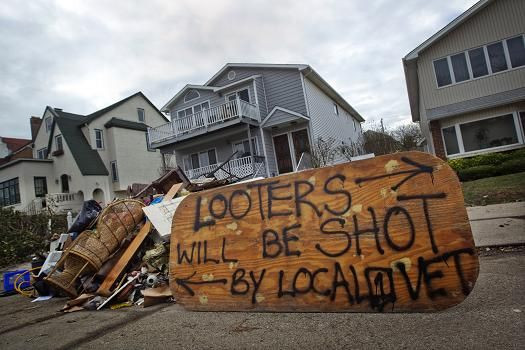Long Island Eye: Freezing In The Dark – Again

We eastern bastards are freezing in the dark – again – on Long Island, where Charles Lindbergh took off for Paris from Roosevelt Field, Nicola Tesla conducted many of his most famous experiments with electricity and Robert Moses built Jones Beach, the World's Fairs and all the parkways that connect us.
How could this Superstorm Sandy catastrophe have plunged 90 percent of us into the dark, displaced thousands of families from homes along the beach in Long Beach, Lindenhurst and Patchogue, with others near the backyard moorings in Freeport, Merrick and Oceanside?
And now, because of a lack of electricity and gas, we've reverted to the good old days of 1973, the Yom Kippur War and the Arab Oil Embargo, in the days when gas cost 27 cents a gallon, to lining up in paranoid queues to get what measly few drops remain at the handful of stations that have it?
Earlier Monday, I approached the Town of North Hempstead coordinator for FEMA who was handing out MREs – meals ready to eat – to residents without power in the Great Neck peninsula, an area with a population around 45,000, half without power.
“Is the problem worse today because it's so cold,” I asked. “No,” he said. “If there'd been a September hurricane, people would be complaining about the heat.”
But now we're freezing in the dark. LIPA, our Long Island Power Authority created by the first Gov. Cuomo from the wreckage of the old Long Island Lighting Company and its ill-fated Shoreham nuclear power plant, in 1985, has hardly had professional management: for years, failed Democratic candidate for state senate and Nassau County Executive Richard Kessel ran it; there's speculation the second Gov. Cuomo will appoint another Democratic politician, North Hempstead Town Supervisor Jon Kaiman, who's been relatively effective, to manage it now.
You don't have to be a genius to realize that an island that juts 120 miles east of Manhattan straight into the Atlantic Ocean will be subject to frequent storms. Terms like “Nor'easter” are frequent here and old-timers remember the great killer storm of 1938 as well as more recent hurricanes like Donna, Gloria and Irene, which last year made landfall at Long Beach.
So when the National Weather Service issued its warning about the “Frankenstorm,” LIPA was caught napping. Out-of-town crews weren't prepared, supervisors weren't in place and squads of tree trimmers and electricians weren't available.
Of course, we also have shortsighted developers and zoning boards to blame. Long Beach, for example, has come light years from its dowdy days as a haven for welfare hotels into a new era of waterfront condominiums. But the new high-rises are built too close to the Atlantic Ocean, so the sand from the beaches is now in their lobbies and streets.
All over the South Shore, developers struggling to build on every last inch have built single-family houses in floodplains, former marshlands and the ocean itself. On Fire Island and in the Hamptons, Wall Street and Hollywood types have erected new mansions too close to the waterfront.
Hasn't anyone been reading the literature about global warming, the melting ice caps and the increase in the ocean levels? The President of Mauritius has complained that in a few decades, his nation will be washed away by this but you've never heard such talk from either the Nassau or Suffolk County Executives, respectively Republican Ed Mangano and Democrat Steve Bellone.
As for the gas lines, the car population is excessive. New zoning codes in the Village of Great Neck mandate space for at least four cars per new house, compared with only two in the old days. Earlier this year, Nassau's Mangano sold the county's LIBus to France's Veolia Environment (Paris: VIE), which renamed it NICE Bus and cut service. Plans for a third track for the Long Island Rail Road are headed nowhere and thoughts about a transit hub in the Uniondale-Mitchel Field area are dead.
So, as with New York City, the lack of planning is entirely manmade. Two consecutive hurricanes, Irene and Sandy, are Nature's early warning system to humans: use your brains to plan, set aside the funds, raise taxes for infrastructure and plan for the 22nd century.
Too much of Long Island is already running a 19th century infrastructure in the 21st century, anyway. Now's the time to plan for our grandchildren's future in the place we call home.
Meanwhile, I'm grateful for less grandiose solutions: friends who installed a gas generator at their house after one too many storms and outages have generously hosted me the past few days. While my neighbors are freezing at night, lack heat, hot water and TV and sit by flashlight and candlelight at night, I felt like Conrad Hilton after a hot shower and a good night's sleep in a warm attic!
© Copyright IBTimes 2024. All rights reserved.






















